Heritage and Sustainability in Lunenburg: Big Strategies for a Small Town
Case Study prepared by Alice Fudge, Carleton University
Keywords: World Heritage Site, Maritime vernacular, Municipal Policy, Sustainability Strategy, Community
LESSONS LEARNED
Since its inscription as a World Heritage Site in 1995, the Town of Lunenburg, Nova Scotia has been a living historic settlement balancing the responsibilities and opportunities that come with the international recognition. This case study examines the strengths of the various strategies for heritage and sustainability put forward for the Town as well as the challenges that weigh upon a small community of roughly 2300 citizens with big aspirations. In particular, the Lunenburg Old Town Sustainability Strategy from 2010 was produced as a tool for the Municipality to build upon their ongoing efforts. A major point from this study is that multiple levels of government funds are required to maintain and advance this World Heritage Site. Years later, it appears that still the Town still struggles with funding and moving forward with the recommended actions.There are costs associated with maintaining a World Heritage Site that are above-and-beyond what a typical (and small) municipality has means for. Lunenburg is given international recognition for its historic and cultural merits, that which draws an international crowd of visitors to see the exemplary site.
As one of Canada’s few World Heritage Cities, it deserves support from deeper pockets…. yet Lunenburg has accomplished a lot. The local government, community organizations, businesses and citizens of Lunenburg have contributed to making their town a livable, viable, and equitable place. As documented by the Nova Scotia Archives, as a “community shaped entirely by the dialogue between land and sea, Lunenburg has always displayed a healthy understanding of itself and a creative approach to its survival. Across two-and-a-half centuries, the community has faced adversity many times, always responding with resiliency and adaptability. When threatened with change and decline, disaster and loss, Lunenburg has simply re-invented itself — on several occasions — and moved on”. The community has proven to be resilient with how its economy can adjust to modern times as well as how to help itself by placing importance on heritage conservation of the town’s unique setting, as well as the preservation of the traditions of their people.
PRESENTATION
On November 21st, 2017, the initial research on Lunenburg Old Town and the municipal strategy for its sustainable future was presented to colleagues of “Heritage Conservation and Sustainability CDNS 4403/5003” lead by Susan Ross. This presentation was an opportunity to share the initial findings and discuss the themes of sustainability and conservation surrounding this case of maintaining a UNESCO World Heritage Site which exists as a small town.
Case Study – presentation AFudge
DESCRIPTION
The Old Town Lunenburg Historic District covers the core area of the town of Lunenburg, a well-preserved example of 18th-century colonization and settlement patterns with numerous outstanding examples of vernacular architecture spanning more than 240 years. It occupies the side of a hill and a narrow area along a natural harbour and includes the town’s original parade square, as well as a waterfront area that is associated with the fishing and shipbuilding industries.
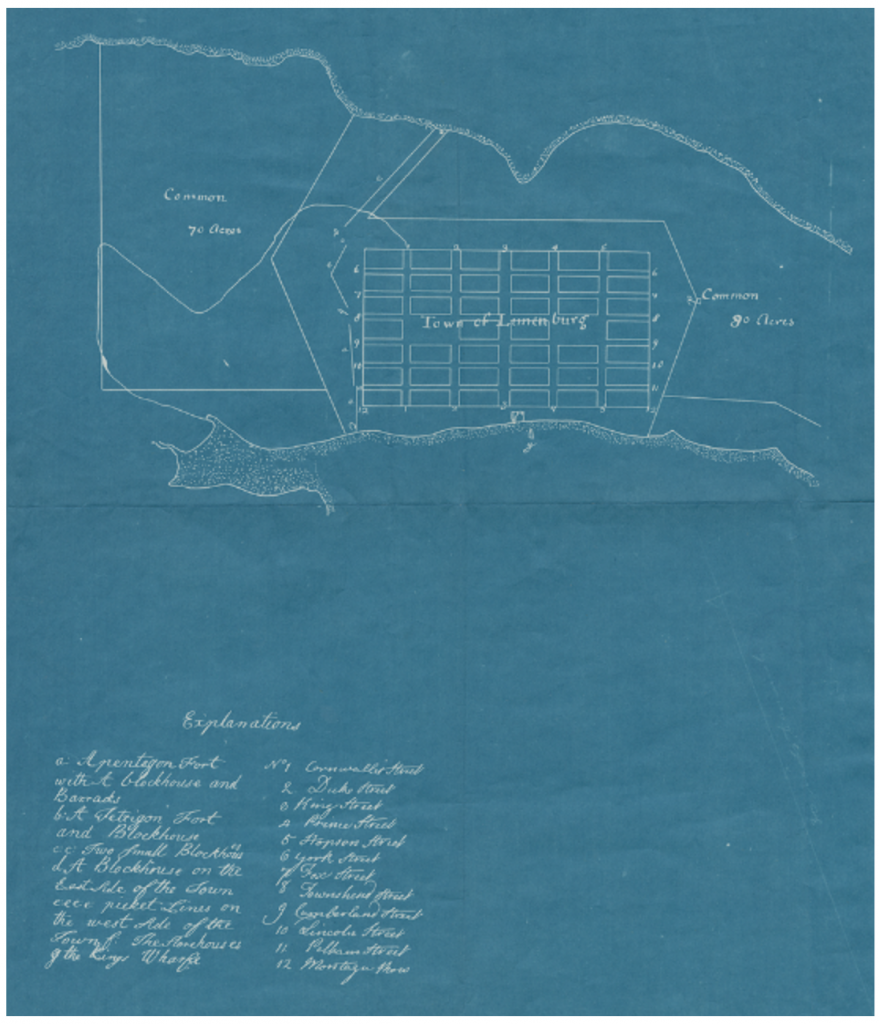
Lunenburg urban plan from 1770, Map Collection Nova Scotia Archives F 239 Lunenburg ca.1770
In 1995 Old Town Lunenburg was designated a World Heritage Site for its distinction as the best surviving example of a planned British colonial settlement in North America. The boundary of the Heritage Site is the same as the municipal Heritage District which includes the historic grid plan of the downtown and waterfront lands and contributing buildings which have been safeguarded by the ongoing efforts of its inhabitants.
Established in 1753, the small town on the coast of Nova Scotia remains small – as in it has not been significantly developed nor seen much population growth. It boasts a largely in-tact stock of Colonial and Victorian heritage buildings and has a working waterfront which continues the long tradition of shipbuilding and fishing. Lunenburg also has a dedicated community and local government which have initiated many organizations, policies, and studies on the conservation and growth of their town. In particular, the Town of Lunenburg Sustainability Strategy from 2010 was produced as a tool for the Municipality to build upon their efforts.
TIMELINE
Town settlement and history
- 1753 – Establishment, European settlers
- 1830-60 – Colonial Era, architectural style construction
- 1870-1900 – Victorian Era, architectural style construction
- 1860-1920s – Off shore Fishing economy
- 1920-40s – ‘Bluenose Era’of shipbuilding; Bluenose II replica built 1963
Heritage designation and planning
- 1972 – Lunenburg Heritage Society established
- 1981 – First Municipal Heritage Property By-law, adopted by Town Council; and creation of the Heritage Advisory Board
- 1991 – Government of Canada Designation: National Historic Site, Old Town Lunenburg
- 1994 – Nomination for World Heritage status
- 1995 – Old Town Lunenburg, added to the UNESCO World Heritage list
- 1998 – Lunenburg Nova Scotia: World Heritage Community Strategy, adopted by Council
- 2000 – Heritage Conservation District Plan, Bylaw and Guidelines, adopted by Council
- 2004 – Lunenburg Waterfront Association, established; purchased the Waterfront lands and wharves form the Province in 2005
- 2010 – Town of Lunenburg Heritage Sustainability Strategy
- 2013 – Planning for Climate Change in the Town of Lunenburg, NS
- 2014 – Town of Lunenburg Strategic Plan, Municipality
- 2015 – Municipal Climate Change Action Plan for the Town of Lunenburg
The timeline for heritage conservation in Lunenburg began in the 1970s when residents of the small costal community acknowledged that they have something unique – and that thing needed attention. As one of Canada’s first settlements, the town boasts a rich heritage; the built and cultural character was intact yet, in the mid to late 1900s with the decline of shipbuilding and fishing industries, its heritage was at risk of depreciating. Its long history, the composition of the town, the vernacular buildings and the maritime culture and economy are all significant, therefore the town decided to recognize the remarkable heritage of Lunenburg and more importantly, decided that it is worthy of attention and protection. In 1972 the establishment of the Lunenburg Heritage Society, by members of the community, preceded any official heritage policy by government and certainly was the pioneering movement for conservation of the town.
The first Municipal Heritage Property By-law for Lunenburg was adopted in 1981, along with the establishment of the Heritage Advisory Board. Momentum built over 10 years leading to the Federal Heritage designation and then achieving status as a World Heritage Site in 1995. This was a large accomplishment with international recognition. Over the decades, the Town of Lunenburg has produced several studies and policies based on sound advice from experienced consultants as well as local expertise.
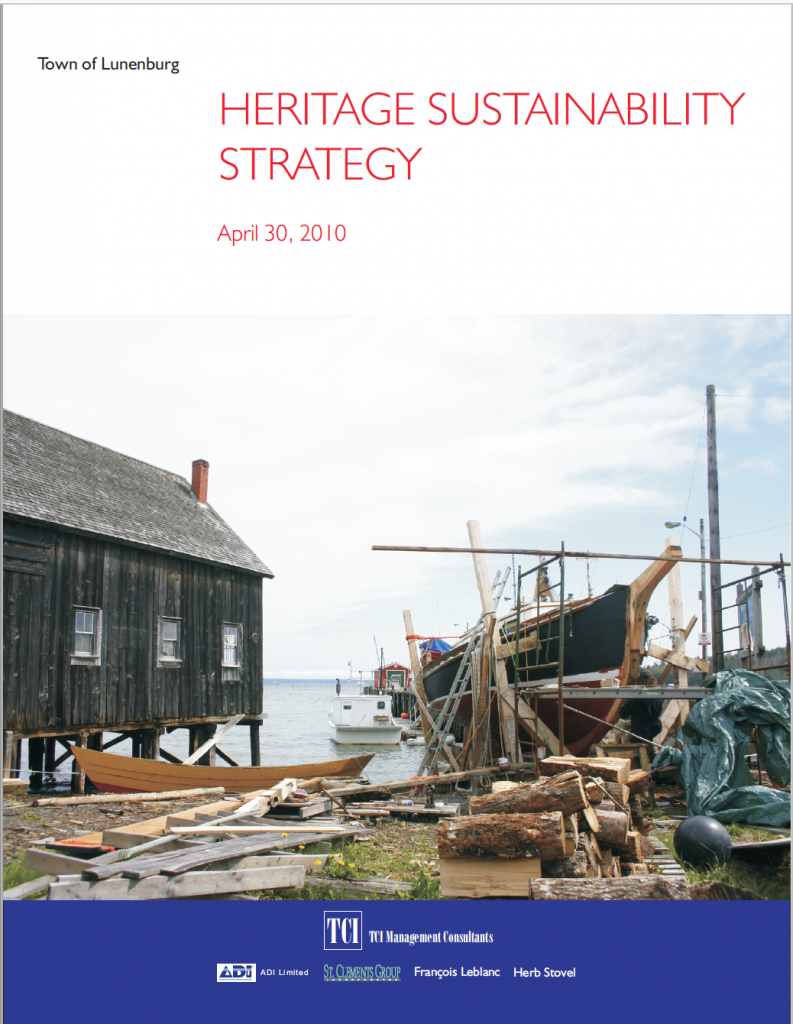
The Town of Lunenburg Sustainability Strategy, is a comprehensive document that has set out a path for the implementation of recommendations for heritage conservation and sustainability and has set goals for “Creating a Livable World Heritage District”. Since that report, the Town has produced its own “Strategic Plan” (2014), which is a succinct document outlining the Town’s vision, targets, and directed with 97 action items! This includes five high-level goals:
-
-
-
- Promote a high quality of life for residents.
- Celebrate our community.
- Champion opportunities for our community’s health and well-being.
- Foster an environment for business success.
- Operate the Town efficiently and effectively.
-
-
In this plan, Lunenburg Mayor Rachel Bailey states, “We look to the citizens of the Town for input on this framework and to help realize our collective vision”. As seen in the timeline, the citizens of Lunenburg have always been a driver of the prosperity and well-being of the community, and the activity in the past twenty years has demonstrated that the citizens and local government are serious about the preservation of the town.
STAKEHOLDERS
Government:
- Parks Canada
- Province of Nova Scotia
- Tourism NS
- Town of Lunenburg, Municipality
-
- Town Council
- Mayor
- Heritage Advisory Board
- Town staff
-
Local:
A committed and interested community has strengthened the
-
-
- Residents, property owners, investors,
- Lunenburg Waterfront Association
- Lunenburg Heritage Society
- Lunenburg Board of Trade
-
Global:
The international recognition as a World Heritage Site was initiated by the nomination by ICOMOS Canada and the designation was decided by UNESCO. These agencies are the presiding legislation.
-
-
- UNESCO World Heritage Committee
- ICOMOS Canada
-
HERITAGE
The heritage value of the Old Town Lunenburg Historic District resides in the original plan, a gridiron layout, one of the earliest and most intact British model plans in Canada, its strong historical associations especially with the Atlantic fisheries, the richness and homogeneity of its architecture and the harmonious integration of the town and the seascape.
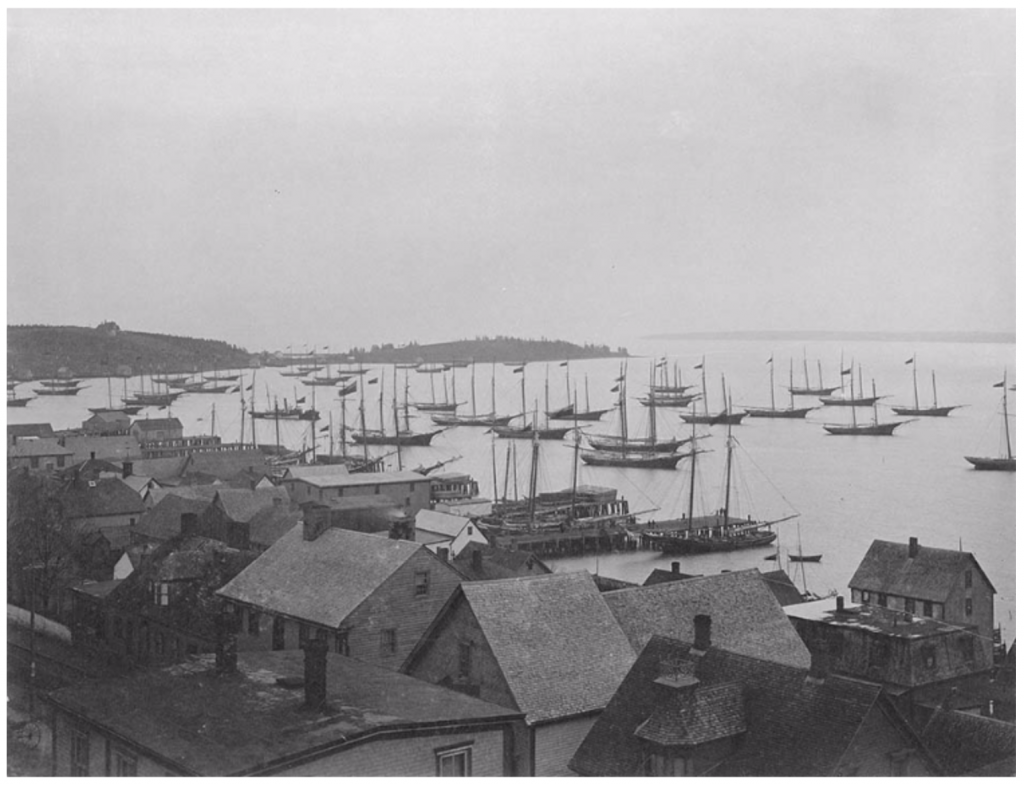
The Harbour at Lunenburg, 1898: Nova Scotia Archives Photo Collection: Places: Lunenburg: Harbour (1) / negative no. N-205, N-8483
To quote UNESCO’s World Heritage Committee’s decision to inscribe Lunenburg: ‘The Committee concluded that Lunenburg Old Town is an outstanding example of the planned European colonial settlement in North America, in terms both of its conception and its remarkable level of conservation.’ The Committee decided to inscribe Lunenburg Old Town on the World Heritage List on the basis of criteria (iv) and (v):
• Criteria (iv): be an outstanding example of a type of building, architectural or technological ensemble or landscape which illustrates (a) significant stage(s) in human history;
Old Town Lunenburg is a well-preserved example of 18th century British colonial urban planning, which has undergone no significant changes since its foundation, and which largely continues to fulfil the economic and social purposes for which it was designed. Of special importance is its diversified and well-preserved vernacular architectural tradition, which spans over 250 years. (Heritage Sustainability Strategy 2010, p. 18)
• Criteria (v): be an outstanding example of a traditional human settlement, land-use, or sea-use which is representative of a culture (or cultures), or human interaction with the environment especially when it has become vulnerable under the impact of irreversible change;
Old Town Lunenburg is an excellent example of an urban community and culture designed for and based on the offshore Atlantic fishery which is undergoing irreversible change and is evolving in a form that cannot yet be fully defined. (Heritage Sustainability Strategy 2010, p. 18)
Natural heritage:
The southern coastline of Nova Scotia is both rugged and picturesque – a unique costal terrain that meets the Atlantic Ocean with a dramatic clash of rock and the swell of sea water. Living by the ocean is a charming notion for newcomers who enjoy the salty air and waters; an entirely different perspective for those who make their living from the sea, fishing or the like, who have endured the harshness of the coastal climate. Lunenburg is situated on the Fairhaven Peninsula at the western side of Mahone Bay; the harbour is sheltered by the peninsula and its geography which is an advantage for mooring/berthing ships.
One of Lunenburg’s defining aspects is the topographical alignment and positioning of the community along the waterfront. The steep hill runs to the water’s edge – a challenge for the streets which are set perpendicular from the waterfront. Also, the hilly setting of the town presents a layered view of the town from the perspective of the sea by ship. Views of the Ocean, the wharves reaching out into the harbour (often with tall ships), and the linear streetscapes lining the hillside are all important aspects of Lunenburg’s natural heritage.
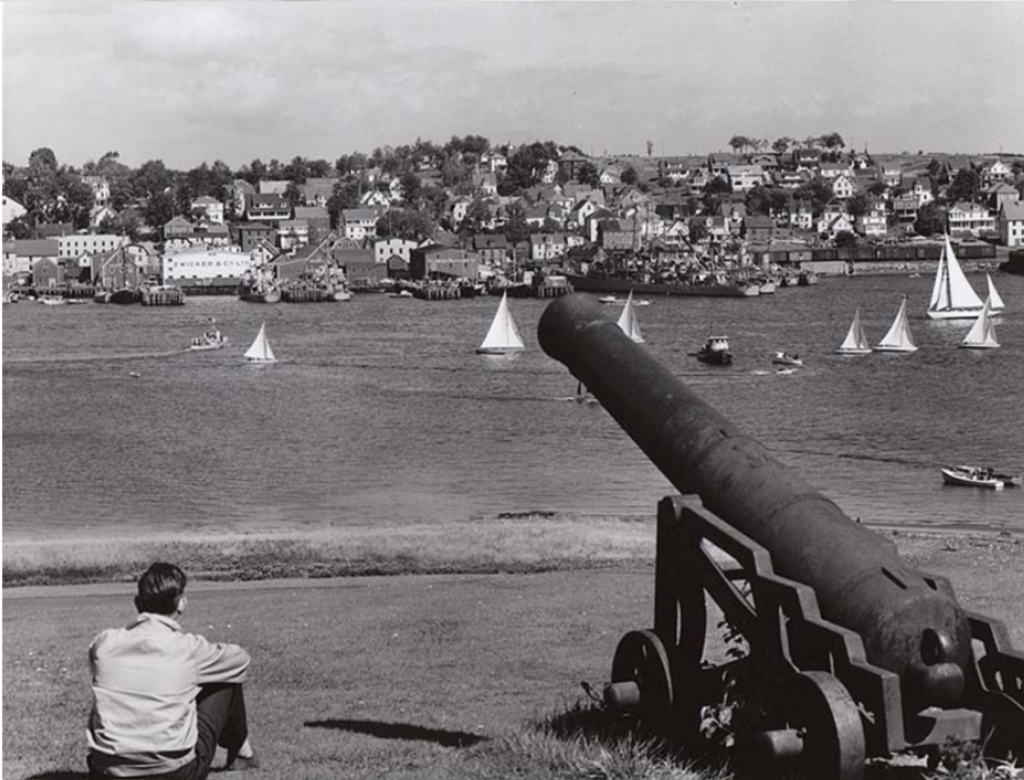
View across the Lunenburg Harbour from the Golf Course, 1955. Nova Scotia Information Service Nova Scotia Archives NSIS no. 9896
Built Heritage:
Despite the differences in style that can occur between the flair of Victorian buildings and the uniform colonial buildings there is homogeneity in the historic fabric of the town. Elements of design which unify the diverse architecture of Lunenburg include the building setbacks along the streets, the building heights, detailing of windows and cornices, and the use of wood as the predominant building material (and of course colourful paint!).
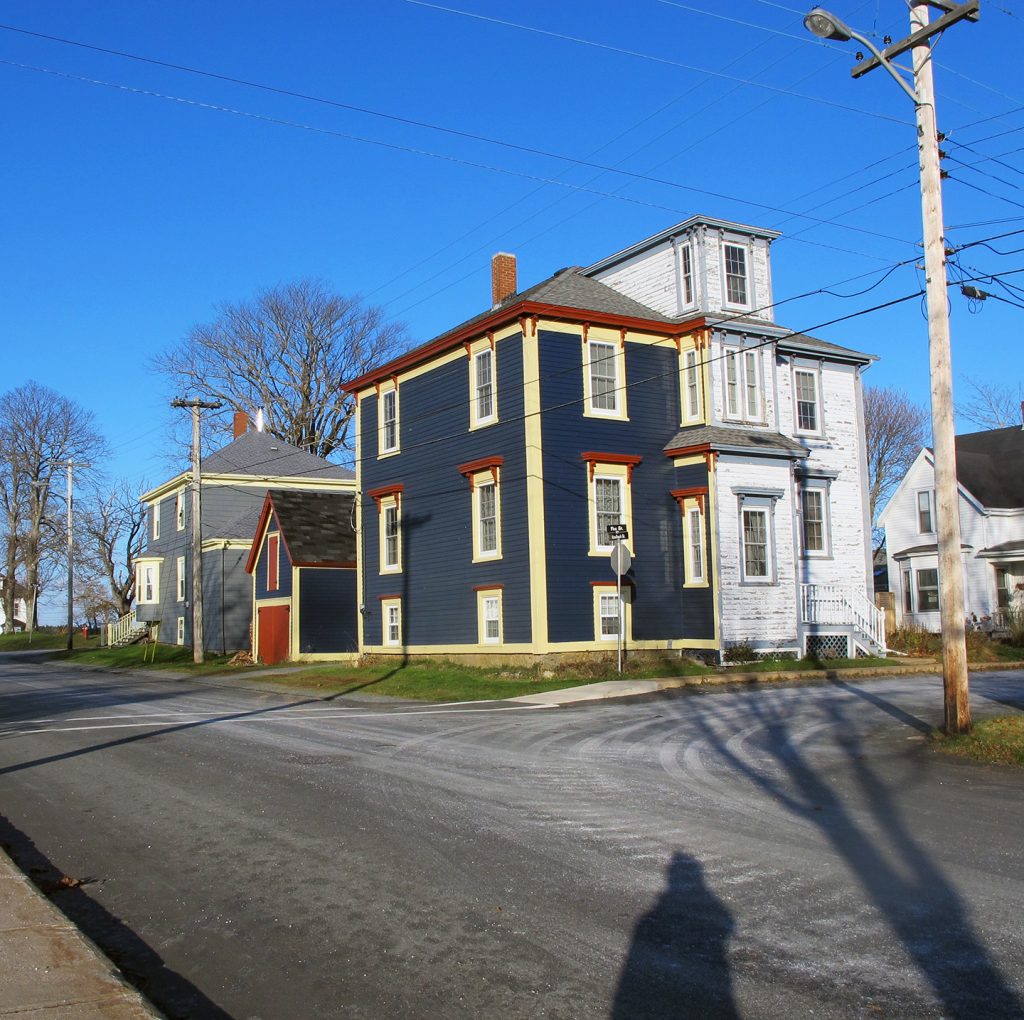
Heritage property receiving a paint job. The Heritage Officer for the Town of Lunenburg manages any alterations to the buildings within the Heritage Conservation District. Photo: Susan Black, November 20, 2014
The Town of Lunenburg manages development within its Heritage Conservation District with the Heritage Properties By-law, and encourages proper conservation practices with incentive grants. The Heritage Conservation District encompasses Old Town Lunenburg World Heritage Site plus buffer areas.
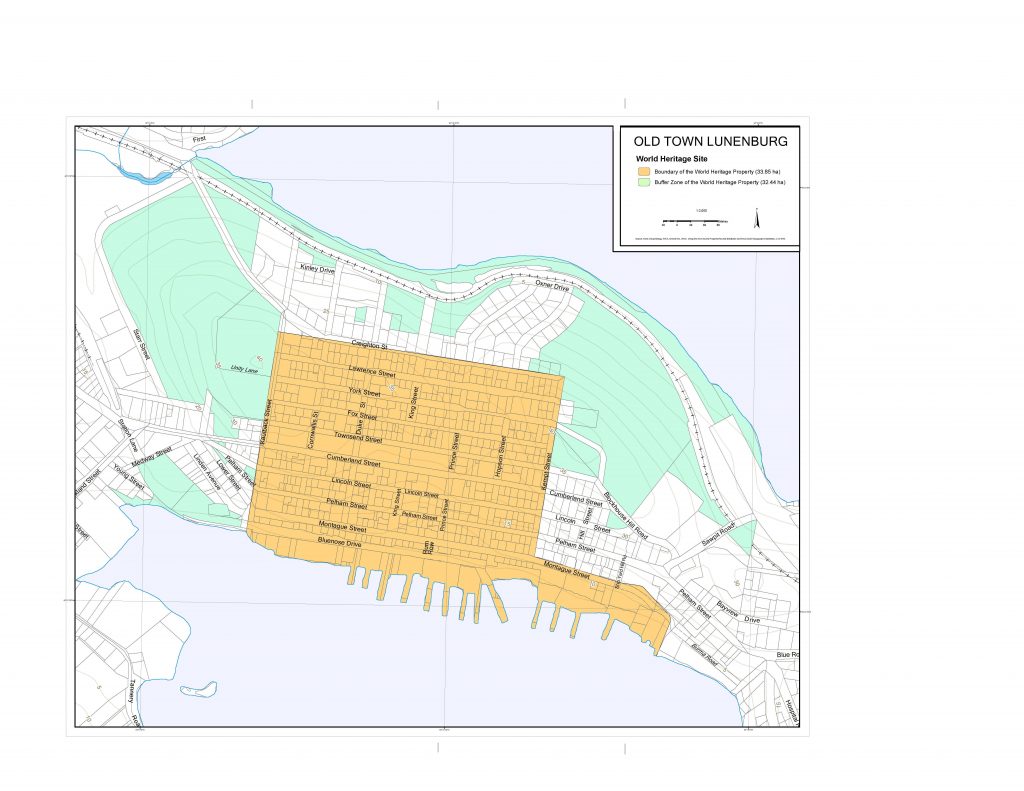
World Heritage Site boundary 2017 http://whc.unesco.org/
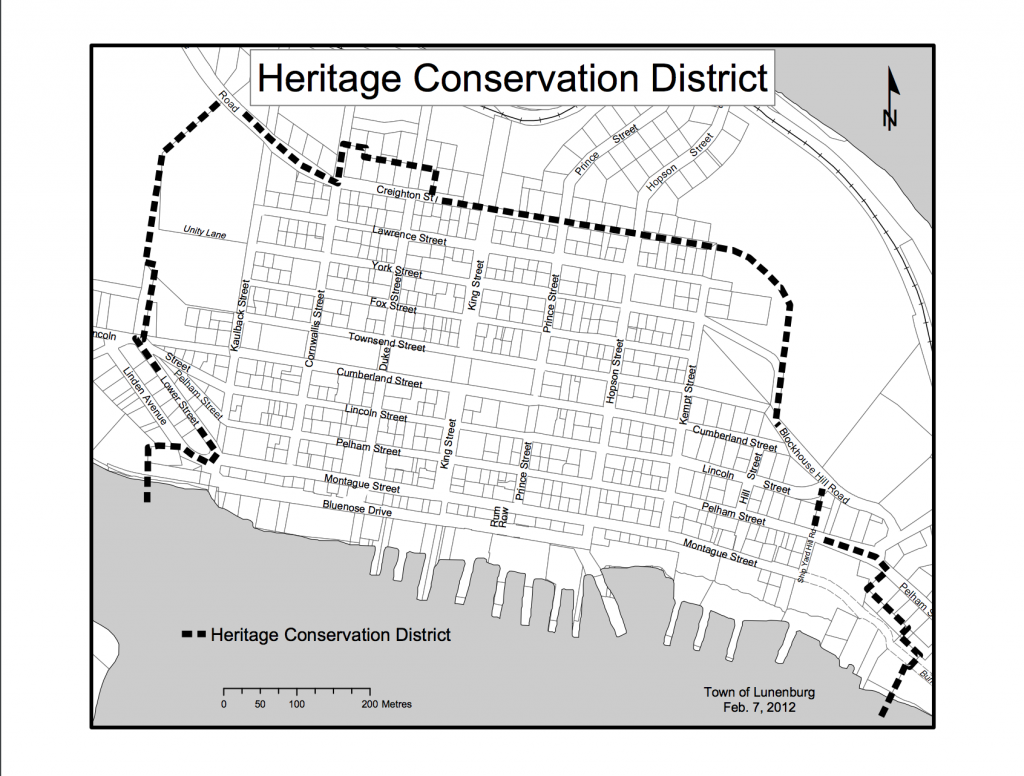
Town of Lunenburg Heritage Conservation District
There are four National Historic Sites of Canada within the town: St. John’s Anglican Church, The Lunenburg Academy, Knaut-Rhuland House, and Old Town Lunenburg District.
SUSTAINABILITY
Environmental sustainability:
In 2013, a study prepared for the Bluenose Coastal Action Foundation by students of School of Planning, Dalhousie University presented the findings of projected long-term impacts of climate change, particularly sea-level rise and storm surge, on the Town of Lunenburg’s physical infrastructure (p. 28)
“Areas of the coast will be permanently inundated due to sea level rise. Of greater concern, however, are the impacts associated with a higher possible storm surge. With local sea level higher, storm surges will reach further inland and could flood areas of the Town of Lunenburg that have not been at risk of flooding in the past. In addition, storms may become more frequent and intense due to climate change, which means that the likelihood of a disastrous storm surge increases” (Forbes and Wightman, p. 7)
The Town of Lunenburg will have to collaborate with UNESCO and with the community to set priorities for managing the affects of climate change.
Cultural sustainability:
The proper management of the built heritage, buildings within the Heritage Conservation District, is an ongoing collaboration between authority and individuals. Providing financial incentives is one way to encourage good practices. Instilling a sense of ownership of the history and of responsibility of the citizens as stewards of that heritage is important.
“The heritage of large-scale vernacular and associative cultural landscapes is usually linked to traditional ownership and management practices. Community involvement is thus not only key to the conservation process, but success depends on applying locally based collaborative strategies that respect cultural, religious, and historical traditions along with ecological systems”. (Cultural landscapes 164 Buggey-Mitchel)
Economic and Social sustainability:
Ship Building: The economic basis of Lunenburg has traditionally been offshore Atlantic fishing, and the necessity of shipbuilding. The ‘Bluenose’ was a fishing and racing schooner built in 1921, and plays a large role in the identity of Lunenburg, and of Nova Scotia. The waterfront remains a place for shipbuilding, however it is no longer the ‘Golden Age of Sail’; the tradition remains active yet agile in order to thrive in contemporary context. There are three remaining ship building companies and related industries, but few new vessels are built, mostly repair and restoration business. Tall ships dock at the long wharves, primarily as an attraction for tourists. The Lunenburg Shipyard Alliance formed in 2010 (a combination of the three ship building companies) for rebuilding of Bluenose II, completed in 2012.
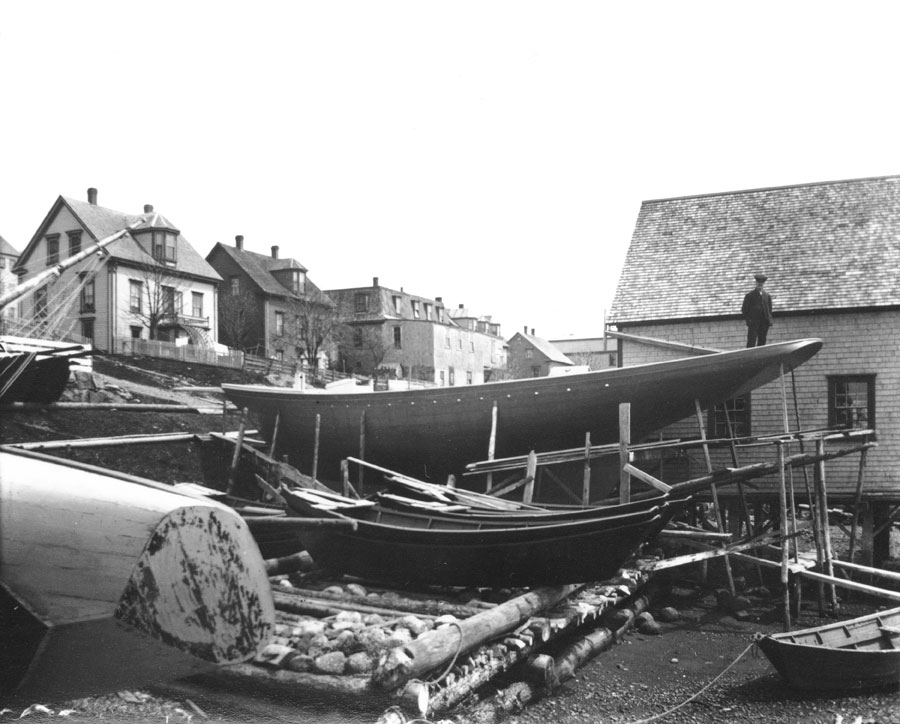
Lunenburg Shipyard, 1900: Bailly Family Nova Scotia Archives accession no. 1985-562 no. 63 / negative no. FP/DN1315
Tourism: The industry has surpassed Lunenburg’s traditional fisheries industry. It poses the challenge of balancing authenticity of the town and its heritage buildings with accommodating the pressure of ‘heritage curb-appeal’ and the commodified historic urban landscape. Heritage and Tourism: they are interdependent. From the text “Cultural Tourism and the Discourse of Sustainability”, Diane Barthel-Bouchier offers the benefits of “seeing tourism as a means of cultural transmission and experience rather than as a form of exploitative market relationship” (p.167). However,
“Tourism has the possibility of providing a source of income, but it is undeniably also a source of change, including change affecting whatever heritage created the source of attraction in the first place”(168 Barthel-Bouchier)
There is a risk of placing too much importance on the ‘look and feel’ of the tourist experience and disregarding the needs of people who actually live in the town. Denis Rodwell discusses his insecurity with the way some historic districts are managed, particularly those who submit to the tourism industry.
“Character’ and ‘appearance’ have reduced much of the role of the conservation officer and urban designer to that of a theatrical set designer, concerned with morphology and architectural detail when viewed from certain public vantage points, skin-deep, and unrelated to the functions of buildings, to the intangible cultural heritage, and to the human traditions of any given place. This role favours a monochromatic view of what constitutes architectural character in any given historic area and it supports pastiche and timidity where replacement or new building occurs. It places preservation of the dominant physical character of a place above past design evolution and above evolutionary enhancement in the future. It ignores continuity of human occupation, activities, and traditions“. (Rodwell, p 62)
New Businesses Ventures: There are some interesting new commercial businesses in Lunenburg, perhaps because of the high quality of life the ocean-side town offers, or perhaps because it is drowned with tourists for the better part of the year. New, non-traditional types of businesses are enhancing the economic climate for Lunenburg.
For example, Ironworks Distillery – a micro-distillery located in a1893 heritage building, a former marine blacksmith’s shop that once produced ironworks for the shipbuilding trade. Their hand crafted liquor has become popular throughout the Maritimes.
Another example is HB Studios is headquartered in beautiful Lunenburg. Founded in 2000 by Jeremy Wellard, this video game production company employs roughly 80 people. The internet has allowed HB Studios to take advantage of the lower cost of space/living and the higher quality of life for its employees.
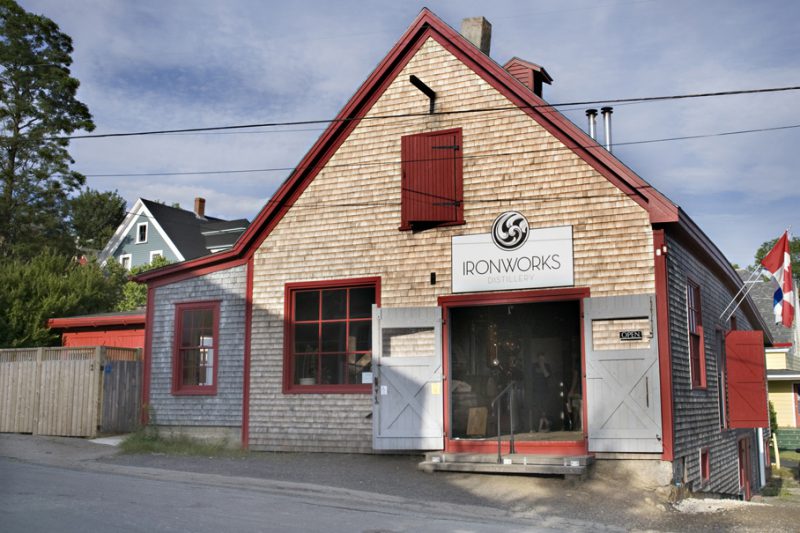
Ironworks Distillery in a restored heritage building. https://ironworksdistillery.com/
MEASUREMENT
Town of Lunenburg: Heritage Sustainability Strategy 2010
“This proposal has been designed to assist the Town of Lunenburg to build on the orientations established within the previous community strategy, to meet and anticipate the emerging challenges confronting the Town and to optimize benefits to be gained from opportunities presented by World Heritage inscription” (p.20)
The five key recommendations are:
|
Key Recommendations |
Observations |
| 1. Establish greater federal partnership with Parks Canada | Further research is required to learn if this partnership has advanced since 2010. |
| 2. Establish greater provincial involvement | Further research is required to learn if this partnership has advanced since 2010. |
| 3. Establish Lunenburg Heritage Foundation | No Foundation has been established. |
| 4. Update ‘Heritage Conservation District Plan and Bylaw with Design Guidelines’ | The Heritage By-law update has not been completed (possibly started); Heritage staff and resources may be an issue. |
| 5. Implement the Heritage Sustainability Strategy | The town appears to be committed to sustainability objectives, however the strategy has not been followed closely. |
REFERENCES
Books/Book chapters/Journal articles
Barthel-Bouchier, D. (2013). “Cultural Tourism and the Discourse of Sustainability,” Cultural Heritage and the Challenge of Sustainability, Walnut Creek, California: Left Coast Press, p.153-176.
Buggey, S. and Mitchell, N. (2008). “Cultural Landscapes: Venues for Community-Based Conservation” in Longstreth, Richard W., editor, Cultural Landscapes: Balancing Nature and Heritage in Preservation Practice. p.164-179.
Rodwell, D., 2003, “Sustainability and the Holistic Approach to the Conservation of Historic Cities,” Journal of Architectural Conservation
Policies and reports
Graham, R.E. [FAIA and Associates]. (May 1998). “Lunenburg Nova Scotia: World Heritage Community Strategy”.
Town of Lunenburg. May 2014. “Town of Lunenburg Strategic Plan”. Retrieved from https://www.explorelunenburg.ca/strategic-plan.html
Town of Lunenburg. (April 2010). “Heritage Sustainability Strategy”. Retrieved from http://ip51.icomos.org/~fleblanc/publications/pub_2010_lunenburg_heritage_strategy.pdf
Forbes, J. and Wightman, J. (April 8, 2013) “Planning for Climate Change in the Town of Lunenburg, NS:Inventory of the Built Environment at Risk to Sea Level Rise and Storm Surge”. Retrieved from https://climatechange.novascotia.ca
Websites
HB Studios. http://www.hb-studios.com/history/
Ironworks Distillery. https://ironworksdistillery.com/
Lunenburg Board of Trade. http://www.lunenburgns.com/living-in-lunenburg/
Lunenburg Heritage Society. http://www.lunenburgheritagesociety.ca
Nova Scotia Archives. (2017) Lunenburg by the Sea. Retrieved from https://novascotia.ca/archives/lunenburg/
World Heritage Centre, (n.d). Old Town Lunenburg. Retrieved from http://whc.unesco.org